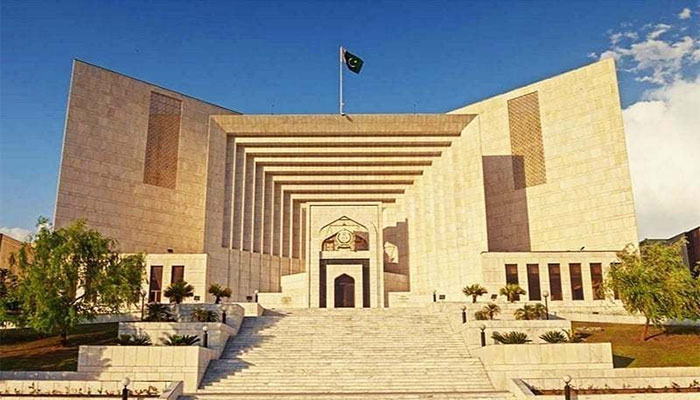Court rulings on rejected ballots
A comprehensive research conducted by prominent lawyer Kashif Malik about several judgments on the subject is available with The News. He said he had a look at the archives of past judicial verdicts to assess the relevance or otherwise of the arguments on the rejection of seven votes by the presiding officer in the Senate chairman’s election.
ISLAMABAD: There is a large amount of case law in the Supreme Court on the question of rejected ballots, the intention and identity of voters and the violation of the secrecy of votes.
A comprehensive research conducted by prominent lawyer Kashif Malik about several judgments on the subject is available with The News. He said he had a look at the archives of past judicial verdicts to assess the relevance or otherwise of the arguments on the rejection of seven votes by the presiding officer in the Senate chairman’s election.
In 1987, the apex court dealt with the issue of ballot papers on which the prescribed mark to indicate the candidate in whose favour the vote was cast was put outside the area containing the name and symbol of the contesting candidate for whom the voter was supposed to have voted.
The judges observed that the cardinal rule to be followed by election officers and courts in election matters is to ascertain the intent of the voter as disclosed by the ballot cast and to give effect to that intent by counting the ballot cast. Non-compliance with the procedure for marking the ballot paper by itself could not ipso facto furnish a ground for rejecting a ballot paper as invalid.
In 1966, the apex court had decided an issue where the ballot papers had borne the official seal but no signatures of the presiding officer (PO). Twelve ballot papers contained chits bearing the words “Bismillah” and 14 ballot papers had currency notes enclosed.
The rejected votes were allowed by the PO to be counted as valid votes by the Election Commission of Pakistan (ECP) member. The high court set aside this order.
However, the apex court ruled that unless there is something to show the previous arrangement, the mere presence of a mark or even the currency note on a ballot paper is not sufficient to identify the electors. The existence of a mark in the absence of a proof of arrangement does not identify the voter.
In 1983, the Supreme Court dealt with the issue of whether the election tribunal can go into the question of the validity of ballot papers for the first time without the PO having examined this question. It was pointed out that the officer had stated that the first respondent had not raised any objection to the votes included in the count of the appellant. “The statement taken at its best can hardly make out a case for estoppels, apart from the well-established rule that there can be no estoppel against the statute”, it was held.
In 1981, the apex court decided an appeal in which five votes which were wrongly excluded from the count were re-examined by the returning officer (RO) and accordingly the petitioner was declared as the returned candidate. It held that any other mark besides the official mark and the prescribed mark would not render the ballot invalid. It ruled that the clear principle for the guidance of POs is that if the ballot paper unambiguously reveals the election of the elector cast his vote in favour of a particular candidate the presence of other marks will not render the vote invalid and the vote will be counted in favour of the candidate for whom the vote appears to have been cast.
In 1988, the apex court decided the issue of marking of ballot papers with Roman numerals instead of English or Urdu numerals. It was held that the votes could only be rejected when with pre-arrangement the identity was disclosed. There is nothing to show that this has been done and there is no such allegation levelled. The intention of the voter is clear as such ballot papers cannot be rejected on this ground.
In 1995, the Supreme Court ruled that where on account of the act of the voter himself the secrecy of the ballot was violated, even in such a case the settled principle of law by the superior courts is that before the rejection of such papers it has to be pleaded first and then proved through evidence that the same was the result of a prior understanding between such a voter and the candidate.
It was held in 2002 that the primary purpose of a mark on a ballot paper was to ensure that the intention of the voter was unambiguously expressed. A mark on the ballot paper which clearly revealed the intention of the voter but did not disclose his identity has to be accepted as a valid exercise of vote and interpretation which could disenfranchise voters ought to be avoided.
It was ruled that where a ballot paper clearly indicated the intention of the voter in casting his vote, and there was no possibility of any doubt or dispute as to the person in whose favour the mark had been made on the ballot paper, such a vote could not be wasted as invalid. Rather discretion should be used in favour of the validity of the vote in preference to the invalidation of the vote in case of doubt. The act of the election tribunal to declare the votes cast in favour of the petitioner as invalid appeared to be arbitrary and illegal, apt to be declared without lawful authority and of no legal effect.
The Indian Supreme Court has held that the mark or writing which would invalidate the ballot paper must be clear as to unerringly point in the direction of the identity of the voter. In the absence of such a mark or writing, the ballot paper cannot be rejected merely because there is some mark or writing on the basis of which the voter may possibly be identified. Thus, every mark or writing would not result in invalidating the ballot paper. The mark or identification should be such as to unerringly reveal the identity of the voter and there must be evidence of prior arrangement in placing the mark with the intention of identification.
The court said if there is any mark or writing on the ballot paper which enables the elector to be identified, the ballot paper would be rejected as invalid. But the mark or writing must be such as would unerringly lead to the identity of the voter. Any mark of writing of an innocuous nature or meaningless import cannot be raised to the level of such suggestive nark or writing as to reveal the identity of the voter.
-
 Prince Harry, Meghan Markle Warned They Can’t Fool Brits Because It Won’t Land
Prince Harry, Meghan Markle Warned They Can’t Fool Brits Because It Won’t Land -
 South Korea’s Ex-president Yoon Suk Yeol, Sentenced To 5 Years In Prison: Key Details Explained
South Korea’s Ex-president Yoon Suk Yeol, Sentenced To 5 Years In Prison: Key Details Explained -
 Princess Beatrice Is ‘terrified’ Of Mom Fergie: ‘She’s Begging Her To Not Destroy Her Future’
Princess Beatrice Is ‘terrified’ Of Mom Fergie: ‘She’s Begging Her To Not Destroy Her Future’ -
 Harry Styles’ New Album Earns Subtle Nod From Zoe Kravitz’s Dad
Harry Styles’ New Album Earns Subtle Nod From Zoe Kravitz’s Dad -
 Ari Emanuel Makes A Decision Regarding His Memoir Alongside Prince Harry’s Ghostwriter
Ari Emanuel Makes A Decision Regarding His Memoir Alongside Prince Harry’s Ghostwriter -
 Buckingham Palace Gives The Spotlight To The Duke And Duchess Of Edinburgh: Video
Buckingham Palace Gives The Spotlight To The Duke And Duchess Of Edinburgh: Video -
 Eva Mendes Revisits Year She Hid Pregnancy
Eva Mendes Revisits Year She Hid Pregnancy -
 Andrew’s Eviction Marks: ‘the End Of Grifting’: ‘It A Catastrophic Fall From Grace’
Andrew’s Eviction Marks: ‘the End Of Grifting’: ‘It A Catastrophic Fall From Grace’ -
 ASAP Rocky Disses Rihanna's Ex Drake In New Track
ASAP Rocky Disses Rihanna's Ex Drake In New Track -
 Jennifer Aniston, Jim Curtis Face One Major Hurdle In Their Union
Jennifer Aniston, Jim Curtis Face One Major Hurdle In Their Union -
 Kate Middleton Reveals Sport She Would Not Play With Prince George
Kate Middleton Reveals Sport She Would Not Play With Prince George -
 Restaurant Workers Detained After ICE Agents Dine At Minnesota Eatery
Restaurant Workers Detained After ICE Agents Dine At Minnesota Eatery -
 First Poll Since King Charles' Action Against Andrew Reveals Royal Family's Public Standing
First Poll Since King Charles' Action Against Andrew Reveals Royal Family's Public Standing -
 Blake Lively Strengthens Legal Team Ahead Of Justin Baldoni Trial
Blake Lively Strengthens Legal Team Ahead Of Justin Baldoni Trial -
 'Back To School!': Palace Shares Details Of Princess Anne's Latest Engagements
'Back To School!': Palace Shares Details Of Princess Anne's Latest Engagements -
 Paul Mescal Clarifies Acting Break Comment As He Teases Paul McCartney Role
Paul Mescal Clarifies Acting Break Comment As He Teases Paul McCartney Role




